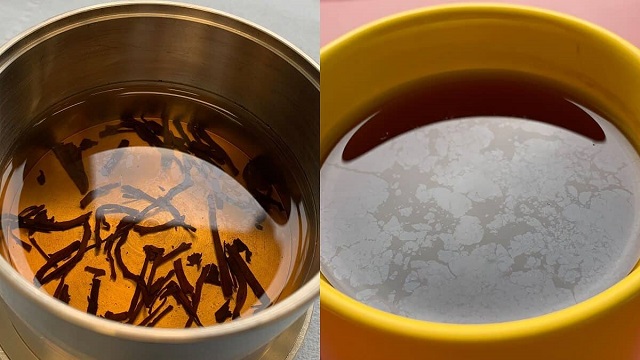Researchers take a closer look at the physics and chemist-tea.
Learn about the compound responsible for the oily film on your tea in this resource for Year 8 Chemistry students.
Word Count: 399

If you’re a black tea fan, you may have noticed the thin, oily film that sometimes forms on the top of the drink. Why does this happen? According to new research, the answer lies not only with the chemistry of the tea, but its physics: specifically, its fluid dynamics.
The oily film on black tea is mostly made of some of the compounds in the tea – particularly, molecules called polyphenols – and calcium carbonate. Calcium carbonate is present in tap water, but its content varies from place to place. A higher concentration of calcium carbonate will create a thicker film.
“Tap water in many regions comes from limestone aquifers, where calcium carbonate, a harmless compound that can make water taste ‘crisper’, is found,” explains Caroline Giacomin, a researcher at ETH Zurich, Switzerland, and co-author on a paper describing the research, published in Physics of Fluids.
(This is also why tea of the same strength can appear darker in some places – calcium carbonate raises the pH of the tea, and tea with a higher pH is darker.)
“If you were to make a cup of tea in perfectly pure water, it would not form a film at all, but the tea would taste quite bitter,” says Giacomin.
Researchers have known for a while that while calcium carbonate makes the oily film thicker, sugar and lemon juice have the opposite effect and thin it out. Milk is more complicated: it can thin the film, but small amounts of milk make it thicker.
In this study, the researchers investigated the rheology, or flow, of the film using a technique called bicone interfacial rheometry.
“Experiments performed involve a metal device placed at the surface of the tea,” says Giacomin.
“The rotation of that device is carefully controlled, and the resistance to rotation that the film applies is what allows us to determine its strength.”
They found there wasn’t a link between the physical thickness of the film and its physical strength. There was, however, a correlation between calcium carbonate concentration and film strength: the more calcium, the stronger the film.
The researchers say this has implications for the manufacture of different types of tea.
“Conditions forming the strongest film, chemically hardened water, may be industrially useful in packaged tea beverages for preferable shelf stability,” they write in their paper.
“Conditions forming weakened films, addition of citric acid, may be useful for dried tea mixes.”
Log in or Sign up for FREE to download a copy of the full teacher resource





